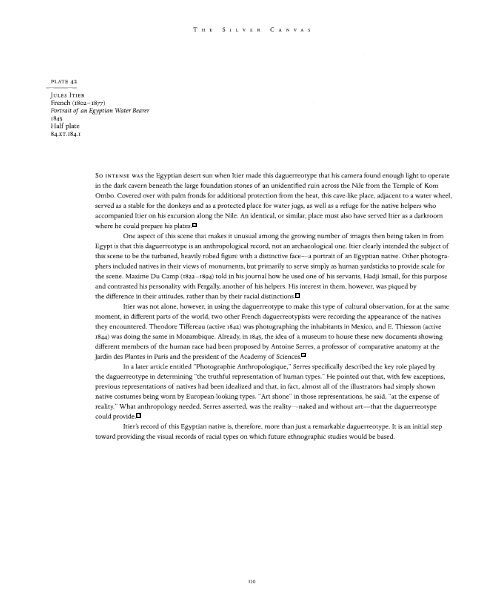The Silver Canvas - Daguerrotype Masterpieces (Art Photography Ebook)
You also want an ePaper? Increase the reach of your titles
YUMPU automatically turns print PDFs into web optimized ePapers that Google loves.
T H E S I L V E R C A N V A S<br />
PLATE 42<br />
JULES ITIER<br />
French (1802-1877)<br />
Portrait of an Egyptian Water Bearer<br />
1845<br />
Half plate<br />
84.XT. 184.1<br />
So INTENSE WAS the Egyptian desert sun when Itier made this daguerreotype that his camera found enough light to operate<br />
in the dark cavern beneath the large foundation stones of an unidentified ruin across the Nile from the Temple of Kom<br />
Ombo. Covered over with palm fronds for additional protection from the heat, this cave-like place, adjacent to a water wheel,<br />
served as a stable for the donkeys and as a protected place for water jugs, as well as a refuge for the native helpers who<br />
accompanied Itier on his excursion along the Nile. An identical, or similar, place must also have served Itier as a darkroom<br />
where he could prepare his plates. 12<br />
One aspect of this scene that makes it unusual among the growing number of images then being taken in from<br />
Egypt is that this daguerreotype is an anthropological record, not an archaeological one. Itier clearly intended the subject of<br />
this scene to be the turbaned, heavily robed figure with a distinctive face—a portrait of an Egyptian native. Other photographers<br />
included natives in their views of monuments, but primarily to serve simply as human yardsticks to provide scale for<br />
the scene. Maxime Du Camp (1822-1894) told in his journal how he used one of his servants, Hadji Ismail, for this purpose<br />
and contrasted his personality with Fergally, another of his helpers. His interest in them, however, was piqued by<br />
the difference in their attitudes, rather than by their racial distinctions. 13<br />
Itier was not alone, however, in using the daguerreotype to make this type of cultural observation, for at the same<br />
moment, in different parts of the world, two other French daguerreotypists were recording the appearance of the natives<br />
they encountered. <strong>The</strong>odore TifFereau (active 1842) was photographing the inhabitants in Mexico, and E. Thiesson (active<br />
1844) was doing the same in Mozambique. Already, in 1845, the idea of a museum to house these new documents showing<br />
different members of the human race had been proposed by Antoine Serres, a professor of comparative anatomy at the<br />
Jardin des Plantes in Paris and the president of the Academy of Sciences. 14<br />
In a later article entitled "Photographic Anthropologique," Serres specifically described the key role played by<br />
the daguerreotype in determining "the truthful representation of human types." He pointed out that, with few exceptions,<br />
previous representations of natives had been idealized and that, in fact, almost all of the illustrators had simply shown<br />
native costumes being worn by European-looking types. "<strong>Art</strong> shone" in those representations, he said, "at the expense of<br />
reality" What anthropology needed, Serres asserted, was the reality—naked and without art—that the daguerreotype<br />
could provide. 15<br />
Itier s record of this Egyptian native is, therefore, more than just a remarkable daguerreotype. It is an initial step<br />
toward providing the visual records of racial types on which future ethnographic studies would be based.<br />
no


